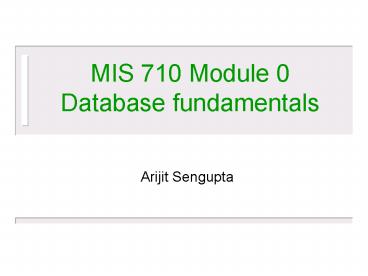MIS 710 Module 0 Database fundamentals - PowerPoint PPT Presentation
1 / 27
Title:
MIS 710 Module 0 Database fundamentals
Description:
The Success of an organization depends on efficient use of its resources: ... Ease of sharing. Ease of use. Data analysis. How? File-based system versus databases ... – PowerPoint PPT presentation
Number of Views:43
Avg rating:3.0/5.0
Title: MIS 710 Module 0 Database fundamentals
1
MIS 710 Module 0Database fundamentals
- Arijit Sengupta
2
Structure of this semester
MIS710
1. Design
4. Advanced Topics
2. Querying
0. Intro
3. Applications
Database Fundamentals
Conceptual Modeling
Query Languages
Java DB Applications JDBC
Transaction Management
Relational Model
Advanced SQL
Data Mining
Normalization
Newbie
Users
Professionals
Designers
Developers
3
Todays buzzwords
- Organizational data cycle
- Database
- Database Management Systems
- Data Independence
- Centralized Database Systems
- Client-Server Database Systems
- Distributed Database Systems
4
Objectives of todays lecture
- Know common database terminology
- Understand requirements and uses of data
- Know the differences between databases and flat
files - Realize the importance and need for databases in
problem-solving - Understand the different types of databases and
their differences
5
Data A Resource
- The Success of an organization depends on
efficient use of its resources - Buildings, factories, equipment
- Technical know-how
- Human resources
- Data
- Data An important organizational resource
6
The Organizational Data Cycle
7
Electronic Data
- Why?
- Large volume in a small space
- Ease of sharing
- Ease of use
- Data analysis
- How?
- File-based system versus databases
8
Legacy (File-based) Systems
- Uncontrolled data redundancy,
- Data inconsistency
- Poor data sharing
- Difficult to keep up with changes
- Record format Vs. user requirements
- Programs Vs. record format
- Low productivity
- High maintenance cost
9
So what is a database?
- According to Oxford English Dictionary
- A structured collection of data held in computer
storage esp. one that incorporates software to
make it accessible in a variety of ways - So does it make pretty much every collection of
data a database?
10
The Database
- The data itself PLUS The data definitions
(metadata), applications, queries and
visualizations
11
Database Approach
- Non-redundant collection of logically related
facts - representing some aspect of the real world
- the data itself plus the data definitions
- Permits sharing
- Consistent representation for each piece of data
- Avoids (minimizes) redundancy
- Allows different user views
- Users are isolated from most changes
12
Why Databases?
- Independence from representation formats
- Control redundancy and consistency
- Ensure integrity/security
- Better scalability
- Allow ad hoc access
- Better maintenance
- Better concurrency
13
Data Independence
- Does data have to be part of programs?
- Do we need to change one if the other changes?
- Three-tier architecture of databases
What the users see
How we model data
How data is stored
14
Access Flexibility
- Easy to ask ad-hoc questions
- No need for separate codes
- User-friendly interface
- Command-based (e.g., SQL)
- Graphical (e.g., QBE)
15
Data Integrity
- Ensures that the stored data are consistent and
correct - Easy to define global rules
- customer_age gt 21 years
- number_of_credits lt 18
- Can allow multiple users to access data without
compromising on data integrity
16
Data Security
- Access definition
- Global
- Local
- Uniform access authorization
17
Data Redundancy
- Data need not be replicated
- Less wastage of storage space
- Less data anomaly
- Reduced and controlled redundancy
- Tighter control of replicated data
18
Standardization
- Everybody talks the same talk.
- Less chance of misunderstanding
- Easier to interpret others data
- Easier to merge
- Useful when several organizations combine to form
one.
19
Productivity and Maintenance
- Increase in productivity
- User-friendly interface
- Independence from specific data structure
- Easier maintenance
- Less code to maintain
- The DBMS is the bulk of the code.
- Ad-hoc queries make it possible to make do with
much less code. - The vendor makes revisions of the DBMS.
- Economy of scale
20
Productivity vs. Maintenance
21
Disadvantages of Databases
- Software complexity
- Processing inefficiency
- Need for co-ordination
- Organizational impact
- Risk
22
DBMS
- A Specialized piece of software that sits between
the data and its users.
DatabaseManagement System
Intension Extension
Data
23
DBMS Functions and Users
- Four major uses of a DBMS package
- Database Development, Interrogation, Maintenance,
and - Application Development
- Automated tools for design, query, and
application development - Database users
- Database administrators ( DBAs )
- Database designer
- End Users
24
Centralized Database Systems
Database
25
Client/Server Database Systems
Client
Database Server
Client
26
Distributed Database Systems
27
Summary
- Data is essential for an organization
- A Database is usually the most effective way of
storing and organizing data - File-based Vs. database systems
- Database system properties
- Types of database systems

